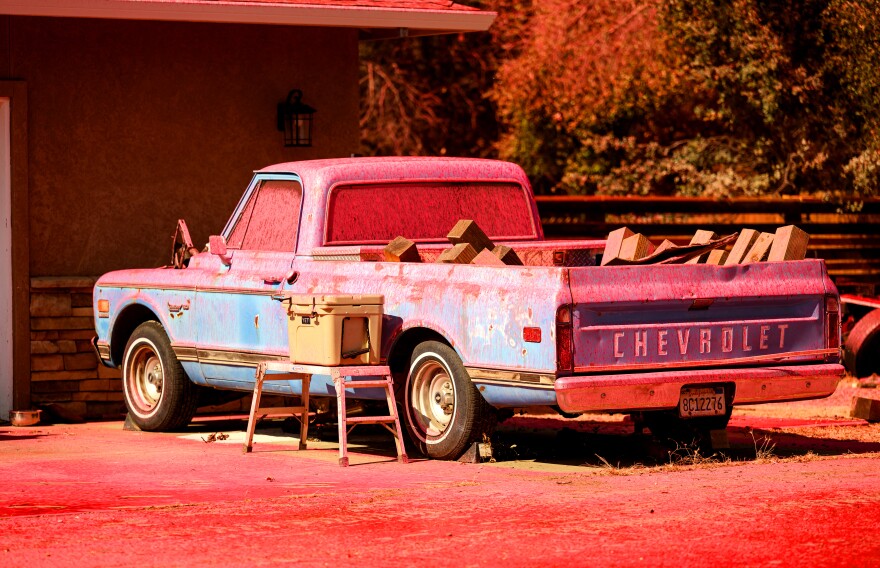Truth matters. Community matters. Your support makes both possible. LAist is one of the few places where news remains independent and free from political and corporate influence. Stand up for truth and for LAist. Make your year-end tax-deductible gift now.
New study raises questions about heavy metals in fire retardants

Over the past decade, about 67 million gallons of fire retardant have been dropped on wildfires across California, according to the U.S. Forest Service.
If you've ever wondered what's in the bright red goop that's used to protect homes and hillsides, a new study out of USC offers clues beyond what the manufacturers show on their official material data sheets. Most concerning is that researchers found heavy metals in products they tested, raising questions about how retardants may contribute to the spread of metals like cadmium and chromium through the environment.
The big takeaways
After a wildfire burns through an area, it's not uncommon to see an increase in heavy metals in waterways once rains wash over denuded surfaces. One such instance occurred after the Station Fire in 2009, when high levels of cadmium were detected in runoff when the rainy season finally came along.
And while metals can come from natural resources like rocks and soils, or burned vegetation, USC researchers found evidence of heavy metals in the 14 different fire retardants they purchased and tested.
"Unfortunately, Phos-Chek LC-95 ... contained potentially concerning concentrations of a few heavy metals, including, chromium, cadmium, and vanadium," said Daniel McCurry, an associate professor in Civil and Environmental Engineering at USC, and a co-author on the paper. "It's not quite a smoking gun, but it at least suggests that it's quite possible these fire suppressants contribute to metal release observed after fires."
Phos-Chek LC-95 is one of the USDA approved retardants in use today, and is just one of several variants manufactured by Perimeter Solutions. The company never responded to LAist's request for comment.
The authors give three possible reasons for the presence of the metals:
- That they're included in the product as a corrosion inhibitor
- That the phosphate ore used in the product could be contaminated
- The metal tanks in which the product is stored is leaching into the mixture

Full disclosure: I'm thanked for my "helpful discussion" in the acknowledgements section of the paper. I reached out to McCurry in 2019, asking about whether we should worry about what's in fire retardant. McCurry, curious, pursued the research along with co-authors Marella Schammel and Samantha Gold.
“This is a really important contribution to the literature. To start thinking about different sources of metal contamination after fires,” said Lauren Magliozzi from the University of Colorado, Boulder, whose research has focused on the topic. She's not associated with the research.
Heavy metals can accumulate in ecosystems, posing a threat to organisms both small and large, as they move up the food chain. Like, from algae to benthic invertebrates to fish, whose endocrine systems can be impacted.
"We really don't want this acute metal toxicity to break down any of those different networks in our ecosystem because then we're starting to worry about ecosystem collapse," Magliozzi said.
Government agencies recognize the risk to waterways posed by the phosphates used in retardant products, and work to prevent drops near waterways, according to both the U.S. Forest Service and Cal Fire.
"We recognize that fire retardant is generally safe in the quantities that are applied to any given area. For sensitive areas like waterways and endangered species habitat, we restrict the use of fire retardant," said Linnea Edmeier, public information officer with Cal Fire. "While Cal Fire prioritizes safety and environmental protection, we also recognize the critical role of fire retardants in firefighting."
The study's limitations
As is often the case with studies, this one is limited in scope.
The researchers highlight one variant of Phos-Chek, but not the version used throughout California by Cal Fire, according to the agency. They said that's because Perimeter Solutions declined to provide samples.
While LC-95 is approved for use by the Forest Service, it's unclear how often and if it's used in California.
To further our understanding of how retardants may contribute to contamination, more data on metal concentrations in waterways both prior to and after fires needs to be gathered.
“We don't quite have a direct A to B connection between metals in the fire suppressants and metals released by wildfires," McCurry said.
He added that they may be able to use unique isotopic signatures in both fire retardant they test and the heavy metals they measure out in the field, which could help them quantify just how much of the contamination is due to the retardant.








